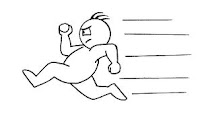The technical grouping of notes can be different from the musical or notational grouping of notes. An understanding of this idea is crucial to the successful playing of quick, virtuoso passages. In Chopin’s “Winter Wind” Etude, for example, the four sextuplets fall technically into groups of four:
This is, of course, only a practice technique, as in speed the pulse reverts to main pulses on every group of six. In this case, it helps here to think of eighth-note triplets.
An even starker example of the importance of grouping begins in measure nine:
In order to move from the fourth finger to the thumb, begin the passage with the hand at a slight angle to the right, placing the thumb nearer to its note. Use the thumb as a hinge to propel the hand into the new position. The thumb usually has two jobs—playing the note and flipping the hand into its new position. Always use the last note of one group in order to arrive at the first note of the next group. Grouping notes together for technical reasons can make the difference between a very difficult execution and a very easy one.

The ability to play fast depends on an understanding of how to group notes. The longer the passage, the more important it is to find sub -groupings. The hand can’t “conceive” of an indefinite number of notes or a long string of notes without establishing milestones along the way. If the composer writes “17” over a group of notes that are to be completed within a certain time frame, it is important to decide on how to sub-divide that group, i.e., three groups of 4 and one of five, or some other grouping that makes sense in the context. This does not mean that accents will be heard; the group of “17” can still sound like a single unit, a flourish, if that is the desired effect. How those sub-divisions relate to the other hand is also a primary consideration.
 Group from the more dense, the heavier combination of notes. For example, in passages where chords are interspersed with single notes, it is much easier to feel a starting point at the chord, regardless of which part of the musical beat it comes on. In Chopin’s G Minor Ballade an arpeggiated figure primarily in single notes contains a chord of a fourth placed on a weak part of the beat that occurs every three notes. By feeling a start on the chord (or a feeling of “down”—notice the red arrows), the passage immediately wants to move with ease. In my view, Chopin meant for these chords to add rhythmic interest to the passage, an agitated syncopation. Hint: use the thumb in the descending passage in order to "rotate" the hand into the new position.
Group from the more dense, the heavier combination of notes. For example, in passages where chords are interspersed with single notes, it is much easier to feel a starting point at the chord, regardless of which part of the musical beat it comes on. In Chopin’s G Minor Ballade an arpeggiated figure primarily in single notes contains a chord of a fourth placed on a weak part of the beat that occurs every three notes. By feeling a start on the chord (or a feeling of “down”—notice the red arrows), the passage immediately wants to move with ease. In my view, Chopin meant for these chords to add rhythmic interest to the passage, an agitated syncopation. Hint: use the thumb in the descending passage in order to "rotate" the hand into the new position.



No comments:
Post a Comment